Hockey: Difference between revisions
Created a unicycle hockey section |
|||
| Line 65: | Line 65: | ||
{{main|Street hockey}} |
{{main|Street hockey}} |
||
Another form of popular hockey is [[street hockey]], sometimes known as road hockey. This is usually played with the same rules as ice hockey, or roller hockey, but on the street. Most of the time, a ball is used instead of a puck, because a puck generates too much friction on an [[asphalt]] or [[cement]] surface and does not slide. Street hockey is played year round. |
Another form of popular hockey is [[street hockey]], sometimes known as road hockey. This is usually played with the same rules as ice hockey, or roller hockey, but on the street. Most of the time, a ball is used instead of a puck, because a puck generates too much friction on an [[asphalt]] or [[cement]] surface and does not slide. Street hockey is played year round. |
||
== Unicycle Hockey == |
|||
| ⚫ | |||
The court used is between 35 and 45 meters in length, and 20 to 25 meters wide. It should have either beveled or rounded corners, and barriers on all sides. The goals are also set back from the end walls, so that play can go behind them, in a similar way to ice hockey. |
|||
Any stick which is legal for [[Ice hockey stick|ice hockey]] other than that of a goalkeeper can be used. The unicycles can have a maximum wheel diameter of 24 inches and a tennis ball is typically used, although street hockey balls are also permitted. |
|||
There are at least two national leagues of unicycle hockey teams. One is in the UK, <ref>[http://www.unicycle.org.uk/uuu/hockey/2010_league UK unicycle hockey league]</ref> with 10 registered teams and the other is in Germany, <ref>[http://www.einradhockeyliga.de/cgi-bin/web/tabelle.cgi German unicycle hockey league]</ref> where there are 53 registered teams. In addition to these leagues, there are individual teams in many other countries.<ref>[http://www3.mpch-mainz.mpg.de/~sander/uni/teamlist.html List of unicycle hockey clubs]</ref> |
|||
It is possible to watch a [http://www.youtube.com/watch?v=dEDhp_-UOYk video of a match here]. |
|||
==Other forms of hockey== |
==Other forms of hockey== |
||
| Line 86: | Line 75: | ||
* [[Box hockey]] is a school yard game played by two people. The object of the game is to move a hockey puck from the center of the box out through a hole placed at the end of the box (known as the goal). Each player kneels and faces one another on either side of the box, and each attempts to move the puck to the hole on their left. |
* [[Box hockey]] is a school yard game played by two people. The object of the game is to move a hockey puck from the center of the box out through a hole placed at the end of the box (known as the goal). Each player kneels and faces one another on either side of the box, and each attempts to move the puck to the hole on their left. |
||
* [[Broomball]] is played on an ice hockey rink, but with a ball instead of a puck and a "broom" (actually a stick with a small plastic implement on the end) in place of the ice hockey stick. Instead of using skates, special shoes are used that have very soft rubbery soles to maximize grip while running around. |
* [[Broomball]] is played on an ice hockey rink, but with a ball instead of a puck and a "broom" (actually a stick with a small plastic implement on the end) in place of the ice hockey stick. Instead of using skates, special shoes are used that have very soft rubbery soles to maximize grip while running around. |
||
[[File:unicyclehockey.jpg|thumb|250px|Unicycle hockey]] |
|||
* [[Deck hockey]] is traditionally played by the [[Royal Navy]] on the ships' decks, using short wooden 'L' shaped sticks. |
* [[Deck hockey]] is traditionally played by the [[Royal Navy]] on the ships' decks, using short wooden 'L' shaped sticks. |
||
<!-- Deleted image removed: [[File:Deck hockey.jpg|thumb|250px|Deck hockey being played by [[Royal Navy]] personnel]] --> |
<!-- Deleted image removed: [[File:Deck hockey.jpg|thumb|250px|Deck hockey being played by [[Royal Navy]] personnel]] --> |
||
| Line 106: | Line 96: | ||
* [[Table hockey games|Table hockey]] is played indoors with a table-top game. |
* [[Table hockey games|Table hockey]] is played indoors with a table-top game. |
||
* [[Underwater hockey]] is played on the bottom of a swimming pool. |
* [[Underwater hockey]] is played on the bottom of a swimming pool. |
||
| ⚫ | |||
== References == |
== References == |
||
Revision as of 20:31, 14 May 2011
Hockey is a family of sports in which two teams play against each other by trying to maneuver a ball or a puck into the opponent's goal using a hockey stick.
History
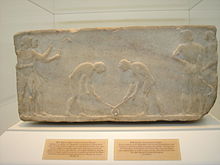
Games played with curved sticks and a ball have been found throughout history and the world. There are 4000-year-old drawings from Egypt. Hurling dates to before 1272 BC in Ireland, and there is a depiction from ca. 600 BC in Ancient Greece where the game may have been called kerētízein or kerhtízein (κερητίζειν) because it was played with a horn (kéras, κέρας)[2] or horn-like stick. In Inner Mongolia, China, the Daur people have been playing beikou, a game similar to modern field hockey, for about 1,000 years.[3] There were hockey-like games throughout Europe during the Middle Ages[citation needed] and the word "hockey" was recorded in 1363 when Edward III of England issued the proclamation: "[m]oreover we ordain that you prohibit under penalty of imprisonment all and sundry from such stone, wood and iron throwing; handball, football, or hockey; coursing and cock-fighting, or other such idle games."[4][clarification needed]
Field hockey
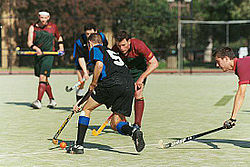
Field hockey is played on gravel, natural grass, sand-based or water-based artificial turf, with a small, hard ball. The game is popular among both males and females in many parts of the world, particularly in Europe, Asia, Australia, New Zealand and South Africa. In most countries, the game is played between single-sex sides, although they can be mixed-sex.
The governing body is the 116-member International Hockey Federation (FIH). Men's field hockey has been played at each summer Olympic Games since 1908 (except 1912 and 1924), while women's field hockey has been played at the Summer Olympic Games since 1980.
Modern field hockey sticks are J-shaped and constructed of a composite of wood, glass fibre or carbon fibre (sometimes both) and have a curved hook at the playing end, a flat surface on the playing side and curved surface on the rear side. While current field hockey appeared in the mid-18th century in England, primarily in schools, it was not until the first half of the 19th century that it became firmly established. The first club was created in 1849 at Blackheath in south-east London. Field hockey is the national sport of India and Pakistan.[5]
Ice hockey
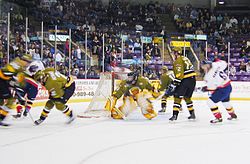
Ice hockey is played on a large flat area of ice, using a three-inch-diameter (76.2 mm) vulcanized rubber disc called a puck. This puck is often frozen before high-level games to decrease the amount of bouncing and friction on the ice. The game is contested between two teams of skaters. The game is played all over North America, Europe and in many other countries around the world to varying extent. It is the most popular sport in Canada, Finland, Latvia, the Czech Republic, and in Slovakia.
The governing body of international play is the 66-member International Ice Hockey Federation (IIHF). Men's ice hockey has been played at the Winter Olympics since 1924, and was in the 1920 Summer Olympics. Women's ice hockey was added to the Winter Olympics in 1998. North America's National Hockey League (NHL) is the strongest professional ice hockey league, drawing top ice hockey players from around the globe. The NHL rules are slightly different from those used in Olympic ice hockey over many categories.
Ice hockey sticks are long L-shaped sticks made of wood, graphite, or composites with a blade at the bottom that can lie flat on the playing surface when the stick is held upright and can curve either way, legally, as to help a left- or right-handed player gain an advantage.
There are early representations and reports of ice hockey-type games being played on ice in the Netherlands, and reports from Canada from the beginning of the nineteenth century, but the modern game was initially organized by students at McGill University, Montreal in 1875 who, by two years later, codified the first set of ice hockey rules and organized the first teams.
Ice hockey is played at a number of levels, by all ages.
Roller hockey
Inline
Inline hockey is a variation of roller hockey very similar to ice hockey, from which it is derived. Inline hockey is played by two teams, consisting of four skaters and one goalie, on a dry rink divided into two halves by a center line, with one net at each end of the rink. The game is played in three 15-minute periods with a variation of the ice hockey off-side rule. Icings are also called, but are usually referred to as illegal clearing. For rink dimensions and an overview of the rules of the game, see IIHF Inline Rules (official rules). Some leagues and competitions do not follow the IIHF regulations, in particular USA Inline and Canada Inline.
Quad
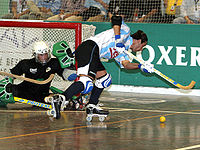
Roller hockey (quad) is an overarching name for a roller sport that has existed since long before inline skates were invented. This sport has been played in sixty countries worldwide and thus has many names worldwide. The sport is also known as quad hockey, international style ball hockey, rink hockey, rollhockey, and Hoquei em Patins among others. Roller hockey was a demonstration roller sport at the 1992 Barcelona Summer Olympics.
Sledge hockey
Sledge hockey is a form of ice hockey designed for players with physical disabilities affecting their lower bodies. Players sit on double-bladed sledges and use two sticks; each stick has a blade at one end and small picks at the other. Players use the sticks to pass, stickhandle and shoot the puck, and to propel their sledges. The rules are very similar to IIHF ice hockey rules.[6]
Canada is a recognized international leader in the development of the sport, and of equipment for players. Much of the equipment for the sport was first developed in Canada, such as sledge hockey sticks laminated with fiberglass, as well as aluminum shafts with hand carved insert blades and special aluminum sledges with regulation skate blades.
Inline sledge hockey
Based on ice sledge hockey, inline sledge hockey is played to the same rules as inline puck hockey (essentially ice hockey played off ice using inline skates) and has been made possible by the design and manufacture of inline sledges by RGK, Europe’s premier sports wheelchair maker.
There is no classification point system dictating who can play inline sledge hockey, unlike the situation with other team sports such as wheelchair basketball and wheelchair rugby. Inline sledge hockey is being developed to allow everyone, regardless of whether they have a disability or not, to complete up to world championship level based solely on talent and ability. This makes inline sledge hockey truly inclusive.
The first game of inline sledge hockey was played at Bisley, England, on the 19th of December 2009 between the Hull Stingrays and the Grimsby Redwings. Matt Lloyd is credited with inventing inline sledge hockey, and Great Britain is seen as the international leader in the game's development.
Street hockey
Another form of popular hockey is street hockey, sometimes known as road hockey. This is usually played with the same rules as ice hockey, or roller hockey, but on the street. Most of the time, a ball is used instead of a puck, because a puck generates too much friction on an asphalt or cement surface and does not slide. Street hockey is played year round.
Other forms of hockey
Other games derived from hockey or its predecessors include the following:
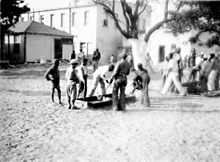
- Air hockey is played indoors with a puck on an air-cushion table.
- Beach hockey, a variation of street hockey, is a common sight on Southern California beaches.
- Ball hockey is played in a gym using sticks and a ball, often a tennis ball with the fuzz removed.
- Bandy is played with a ball on a football field-sized ice arena, typically outdoors, and with many rules similar to association football
- Box hockey is a school yard game played by two people. The object of the game is to move a hockey puck from the center of the box out through a hole placed at the end of the box (known as the goal). Each player kneels and faces one another on either side of the box, and each attempts to move the puck to the hole on their left.
- Broomball is played on an ice hockey rink, but with a ball instead of a puck and a "broom" (actually a stick with a small plastic implement on the end) in place of the ice hockey stick. Instead of using skates, special shoes are used that have very soft rubbery soles to maximize grip while running around.

- Deck hockey is traditionally played by the Royal Navy on the ships' decks, using short wooden 'L' shaped sticks.
- Floor hockey is a form of hockey played on foot,on flat, smooth floor surface. It is usually played inside in gymnasiums and such.
- Floorball, is a form of hockey played in a gymnasium or in sport halls. A whiffle ball is used instead of a plastic ball, and the sticks are made from composite materials. The sticks are only one meter long.
- Foot hockey or sock hockey is played using a bald tennis ball or rolled up pair of socks and using only the feet. It is popular at elementary schools in the winter.
- Gym hockey is a form of ice hockey played in a gymnasium. It uses sticks with foam ends and a foam ball or a plastic puck.
- Hurling and Camogie are Irish games bearing some resemblance to - and notable differences from - hockey.
- Indoor field hockey is an indoor variation of field hockey.
- Mini hockey In the United States is a form of hockey (also known as "mini-sticks") which is played in basements of houses. Players get down on their knees, using a miniature plastic stick, usually about 15 inches (38 cm) long to maneuver a small ball or a soft, fabric covered mini puck into a miniature goals. In England 'mini hockey' refers to a seven-a-side version of field hockey, played on an area equivalent to half a normal pitch for younger players
- Nok Hockey is a table-top version of hockey played with no defense and a small block in front of the goal.
- Power hockey is a form of hockey for persons requiring the use of an electric (power) wheelchair in daily life. PowerHockey is a competitive sports opportunity for the physically disabled.
- Ringette is an ice hockey variant that was designed for female players; it uses a straight stick and a rubber ring in place of a puck. Note: Ringette distances itself from hockey as it has its own set of rules and is closely related to a mix of lacrosse and basketball.
- Rinkball is a Scandinavian team sport, played in an ice hockey rink with a ball.
- Rossall hockey is a variation played at Rossall School on the sea shore in the winter months. Its rules are a mix of field hockey, rugby and the Eton wall game.
- Shinny is an informal version of ice hockey.
- Shinty is a Scottish game now played primarily in the Highlands
- Skater hockey is a variant of inline hockey, played with a ball.
- Spongee is a cross between ice hockey and broomball and is most popular in Manitoba, Canada. A stick and puck are used as in hockey (the puck is a softer version called a "sponge puck"), and the same soft-soled shoes used in broomball are worn. The rules are basically the same as ice hockey, but one variation has an extra player on the ice called a "rover".
- Table hockey is played indoors with a table-top game.
- Underwater hockey is played on the bottom of a swimming pool.
- Unicycle hockey is similar to roller or inline hockey, however, each player must be mounted on their unicycle (with both feet on the pedals) to play at the ball. Video of a match here
References
- ^ Stein, Victor; Rubino, Paul (2008) [1994]. The Billiard Encyclopedia (3rd ed.). New York: Balkline Press. pp. pp. 2, 5, 27. ISBN 9780615170923.
{{cite book}}:|pages=has extra text (help) - ^ Oikonomos, G. "Κερητίζοντες". Archaiologikon Deltion 6 (1920-1921): 56-59; there are clear depictions of the game, but the identification with the name κερητίζειν is disputed at http://sarantakos.wordpress.com/2010/03/29/keretizein/ (English summary at http://hellenisteukontos.blogspot.com/2010/03/ancient-greek-field-hockey.html)
- ^ McGrath, Charles (August 22, 2008). "A Chinese Hinterland, Fertile with Field Hockey". New York Times. Retrieved 2008-08-23.
- ^ http://www.rugbyfootballhistory.com/originsofrugby.htm accessed 2009-03-12
- ^ Hockey,Field Hockey,Hockey Game,Hockey Sports,Hockey History,Hockey India
- ^ International Paralympic Committee. "Ice Sledge Hockey — Rulebook" (PDF). Retrieved October 11, 2006.
